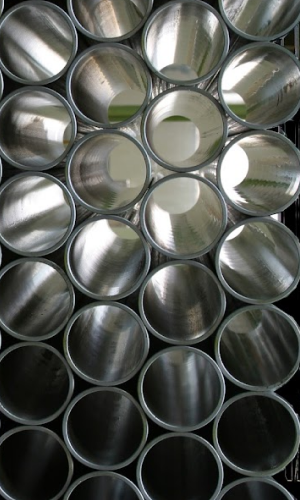Steels are iron alloys containing less than 2% carbon, obtained by casting and plastic working. Steels with a small concentration of other elements in the form of admixtures or impurities are carbon steels. Admixtures that have a beneficial effect on the properties of steel are: manganese, silicon, chromium, nickel and copper. On the other hand, impurities such as phosphorus, sulfur, oxygen, hydrogen and nitrogen have a negative impact on the properties of steel.

Calculate the weight of pipes
Alloying additives are elements introduced into steel deliberately in amounts exceeding the minimum concentration. The minimum concentration is such a concentration at which no effect of the element on the structure and properties of steel is found (minimum concentrations are specified in the relevant standards).
Alloying additives affect:
– steel structure,
– chemical or physical properties of steel,
– strength and plastic properties of steel,
– technology and effects of heat treatment.
COAL (C)
A steel component that mainly determines the mechanical properties of steel. The higher the carbon content, the higher the tensile strength, yield strength and hardness, and the lower the impact strength, elongation and necking. An increase in the carbon content in steel deteriorates its weldability.
CHROME (Cr)
It is the most commonly used additive in alloy steels. Intensively increases the hardenability of steel. In alloy steels with a content above 12%, chromium provides anti-corrosion properties (stainlessness, heat resistance, resistance to acids and other chemically active substances). In energy steels, i.e. intended for operation at elevated temperatures, chromium increases the strength and hardness of these steels.
SILICON (Si)
It is used in the steelmaking process as a deoxidizer. In the group of carbon steels, depending on the silicon content, we distinguish: a) non-killed steels (0.03% Si), b) semi-killed steels (approx. 0.17% Si) and c) killed steels (0.17-0.40% Si) characterized by a homogeneous structure. The silicon content increases the strength and hardness of the steel in the annealed condition. In combination with chromium and molybdenum, silicon increases the heat resistance and creep resistance of steel. Silicon-containing steels are also used as construction materials with special magnetic and electrical properties.
MANGANESE (Mn)
It is a cheap and readily available supplement. It increases the hardness and strength of steel and reduces its plastic properties. Manganese steels are characterized by an increased elastic limit and increased abrasion resistance.
NICKEL (Ni)
Among all alloy additives, nickel has the most beneficial effect on increasing the strength and hardness of steel while maintaining high impact strength. Nickel significantly lowers the brittleness threshold temperature of steel. Steels with a nickel content of 3-9% are used for work at very low temperatures (cryogenic steels).
COPPER (Cu)
Added in the amount of up to 0.55%, it is used in the group of hard-rusting steels, which are characterized by good resistance to atmospheric corrosion. The addition of 2-3% copper to chromium-nickel steels increases their resistance to aggressive acids (such as hydrochloric acid or sulfuric acid).
MOLYBDENUM (Mo)
It is commonly used in structural, tool and high-alloy steels for special purposes. The addition of molybdenum intensively increases the hardenability of steel (much stronger than chromium and tungsten). Molybdenum-containing steels are much more resistant to pitting corrosion in chloride-containing environments (e.g. in mine water, industrial water or sea water).
VANADIUM (V)
The addition of this element in steel increases its resistance to overheating and contributes to the preservation of the fine-grained structure of the steel.
TITANIUM (Ti)
The addition of titanium introduced into corrosion-resistant steels stabilizes the carbon, thus preventing the phenomenon of intergranular corrosion.
NIOB (Nb)
In corrosion-resistant steels, it works similarly to titanium.
COBALT (Co)
As the only alloy additive, it increases the critical cooling rate, thus reducing the hardenability of steel. Cobalt is used as an additive in high-alloy tool steels. In high-speed steels (5 and 10%), cobalt increases the melting point and prevents the steel from overheating during hardening.
TUNGSTEN (W)
It increases the hardenability of steel, but to a lesser extent than molybdenum, chromium or nickel. Steel with the addition of tungsten (from a few to over a dozen percent) becomes very resistant to tempering and retains the mechanical properties obtained as a result of hardening to a temperature of about 600°C. The content of very hard and durable tungsten carbides gives the steel high abrasion and wear resistance. Tools made of such steel have a high cutting capacity and their blades are resistant to abrasion.
ALUMINIUM (Al)
The addition of aluminum in the amount of 0.02-0.2% has a strong deoxidizing and denitrifying effect. Nitrogen in unalloyed steels causes the so-called steel aging. The use of the addition of aluminum in an amount that effectively binds nitrogen prevents this unfavorable phenomenon.
BORON (B)
A small addition of boron significantly increases the abrasion resistance of the steel. With a content of 0.003%, it has a very strong effect on increasing the hardenability of steel.
SULFUR (S)
It is a particularly harmful pollutant. It occurs in steel in the form of sulfides. Iron sulphides cause brittleness of steel during hot working. Sulfur is particularly undesirable in steels intended for welded structures because it greatly increases the tendency of a welded joint to form hot cracks in the weld area or in the heat affected zone.
PHOSPHORUS (P)
The content of phosphorus in steel significantly reduces its plastic properties. It causes embrittlement during cold working. Phosphorus can cause variations in the structure and properties of steel.
HYDROGEN (H)
It adversely affects the mechanical properties of steel. It easily dissolves in the steel structure, creating bubbles in the form of so-called snowflakes, which are a defect in the steel (steel hydrogen disease).
NITROGEN (N)
When dissolved in steel, it forms nitrides that reduce its plastic properties. This phenomenon is called steel aging. The presence of free nitrogen in unalloyed low-carbon steels poses a high risk of crack formation both during the welding of the steel and during the operation of the welded structure.